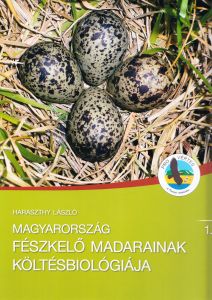
Haraszthy László: Magyarország fészkelő madarainak költésbiológiája. 1-2. kötet. Pro Vértes Zrt., Csákvár, 2019. 953+827 p., 2262 photos
The author is a founding member of BirdLife Hungary, who has been its executive secretary, deputy chairman, executive chairman since 1975, and is a member of the presidium even today. Since the early 1970s he has been engaged in ornithology, and wrote a great number of articles in ornithology and nature conservation, and authored or edited several books as well. The search for nests and their documentation has constituted a considerable part of his ornithological research. The extensive material he has been gathering for about 30 years is published now.
 The two volumes cover 240 species of birds nesting in Hungary in four categories: regular, occasional, extinct, potentially nesting. The author has found the nests of all species with the exception of 18. He recorded some of the ”hard-to-find” ones abroad in 14 different countries. The majority of the 2,262 photographies were taken by the author. The author was helped by a great number of people who contributed to the completion of the coverage by reporting on actual nesting, field visits with the author, and other pieces of information. They are all enumerated on the two long pages of acknowledgements.
The two volumes cover 240 species of birds nesting in Hungary in four categories: regular, occasional, extinct, potentially nesting. The author has found the nests of all species with the exception of 18. He recorded some of the ”hard-to-find” ones abroad in 14 different countries. The majority of the 2,262 photographies were taken by the author. The author was helped by a great number of people who contributed to the completion of the coverage by reporting on actual nesting, field visits with the author, and other pieces of information. They are all enumerated on the two long pages of acknowledgements.
The general information chapter, intended as an introduction, is very useful, especially for the definitions it gives.
The sections on breeding species have the following structure: nesting place; nesting time; place of the nest; material and size of the nest; shape, colour and size of the eggs; number of eggs; time of incubation and rearing of young ones; breeding success; curiosities; bibliography.
There is an average of 6–12 photographs for each species illustrating not only the variability of eggs and nests, but also the environment. The documentation of the great variability of eggs, nests, and nesting places is really instructive, for example in the case of the 61 photos taken of the nests of the black-headed gull.
Biometric data were gathered with meticulous work from the literature with special focus on Hungarian data when it was available.
The 28-page general bibliography is impressive, and I am glad I could contribute to it a little bit as a librarian.
The work is concluded by interesting informal stories and adventures, illustrated by photos, which give an insight into the difficulties, hardships, and surprises encountered during field work, and the role of the helpers which was often indispensable.
The only similar book is the two-volume work by W. Makatsch entitled Die Eier der Vögel Europas published in 1974–1976. This book is outdated in many respects, and almost impossible to purchase. The majority of its illustrations are black-and-white, and the variability of eggs and nests is tackled only briefly in the text, There are hardly any photos of the environment of the nests in it.
In the early 1980s BirdLife Hungary considered the idea of implementing the greatly successful nest monitoring project of BTO (British Trust for Ornithology). The programme was not initiated, though, considering its success in Great Britain, it would not be imprudent to suppose that it could have been useful in Hungary as well. It is well-known that approaching a nest may endanger the success of breeding. However, with professionalism, caution, and self-discipline, it is possible to minimize this risk. There is no reason to doubt that the author carried out his research armed with all these qualities. Meantime, data regarding thousands of nests found by accident were lost due to the lack of such a programme in Hungary. This two-volume book makes up for this lack. Bird watchers in the field inevitably come across nests. This book was compiled for them.
It is regrettable that the book could not come out in English as well. The fact that the captions of illustrations are given in English, too, does not make up for the lack of the English text. Though no review was published in any foreign journal of the book, there were dozens of orders from abroad.
The two volumes weigh 8 kilos, and this makes their use a bit difficult. It might have been a better to divide the material into more volumes.
Anyway, the book fills a gap, and will certainly be an important reference work in the next 50 years.
Its price is 22.000 HUF from the publisher, but they do not deal with dispatching it. Hungarian distributors obviously offer it for a somewhat higher price, but the book is still inexpensive as compared to similar foreign publications.
József Büki

